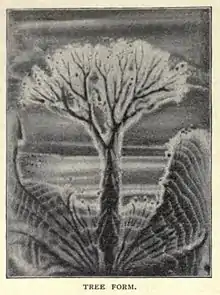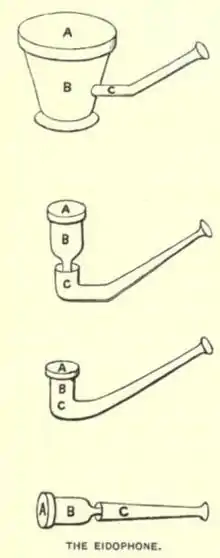Megan Watts Hughes
Megan [Margaret] Watts Hughes (12 February 1842 – 29 October 1907) was a Welsh singer, songwriter, scientist and philanthropist. Her name appears as Margaret, the equivalent of the Welsh name Megan,[2] in several publications.[3][4][5] She was recognised by certain sources as the first to experiment with and observe the phenomenon of visualizing resonating sound using a device she invented called an "eidophone".[6] The device or instrument naturally-produced geometric patterns from the resonation of her human voice. As a result, she referred to images as "Voice-Figures." Her work eventually resulted in a 1904 book titled The Eidophone; Voice Figures: Geometrical and Natural Forms Produced by Vibrations of the Human Voice, penned by Margaret Watts Hughes.[7] She demonstrated the instrument for the Royal Society.
| Megan Watts Hughes | |
|---|---|
| Occupation | Singer, songwriter, scientist and philanthropist |
| Known for | voice-figures |

Early life and musical career
She was born Megan Watts in Dowlais, Glamorgan[shire],[3] a historic county in southern Wales, to parents who had relocated from Pembrokeshire. Her father supervised the local cemetery. Following early success as a singer on the South Wales concert circuit, she obtained singing lessons from two leading Cardiff musicians, and in 1864 began studies at the Royal Academy of Music in London, where her teachers included Manuel García. However, she was forced to abandon her studies by ill-health. After marrying Hugh Lloyd Hughes in 1871, she became known as Mrs Watts Hughes and continued her musical career under that name. A deeply religious woman, she thought of Bethania Chapel as her spiritual home.[8] At Mountford House in Barnsbury Square, Islington, she founded a "Home for Little Boys".[9]
In a newspaper article of 1898, composer Joseph Parry referred to Megan Watts Hughes as being one of "our greatest vocalists".[10] She had accompanied Parry on a "musical tour" of North Wales after leaving the Royal Academy of Music, and once appeared with Jenny Lind, one of the greatest sopranos of the day (who had also been trained by García). Lind is supposed to have said of her: "I have never met anyone so related to me in the art of music. Two sisters only have I in the art-Madame Schumann and Mrs. Megan Watts-Hughes."[8] Mrs Watts Hughes wrote the hymn-tune "Wilton Square" and a number of other songs.[11]
"Voice-figures"

In 1885, while exercising her voice, she accidentally discovered what she called "voice-figures" or "voice-flowers", patterns created by the natural phenomenon of standing-wave resonance. She described the process which began with sand and/or lycopodium powder and later "flooding the disk of the eidophone with a thin layer of liquid, e.g., water or milk."[12] Vibrations registered as patterns on the disc of the eidophone. She described the patterns as "beautiful crispations" which would only appear if the pitches sung were not too forced. She experimented with and found that coloured glycerine produced intricate flower-like patterns in the liquid.[13]
Her scientific observations were first published in an 1891 Century Magazine article under the name Margaret Watts Hughes. She wrote that she had already presented her findings at The Musical Association, The Royal Institution, and the Royal Society in London, which was considered unusual for a woman in that period. Using her own photography and diagrams (pictured on the right), the article described her process and her invention in detail:
In 1885, while seeking means to indicate readily the intensities of vocal sounds, I first met with these [voice] figures, and, owing to their variety both in form and production, they have since absorbed much of my attention. The apparatus I have employed I call the eidophone. This is very simple. It consists merely of an elastic membrane, such as thoroughly flexible soft sheet-rubber, tightly stretched over the mouth of a receiver of any form, into which receiver the voice is introduced by a wide-mouthed tube of convenient shape. In some cases the receiver may be dispensed with, and the membrane be stretched across the open end of the tube itself.[12][14]
This process would later be linked to the independent invention of research begun by Ernst Chladni, who used powder rather than liquid to facilitate the visual patterns. Watts Hughes' work was not only demonstrated at a scientific meeting of the Royal Society,[6] her scientific paper in 1891[1] led her to publish a 47-page book that extensively detailed how she made sound visible. The book was entitled The Eidophone Voice Figures: Geometrical and Natural Forms Produced by Vibrations of the Human Voice, published in 1904.[7] Her work along with Ernst Chladni became progenitors of a field called Cymatics[15] forwarded by Swiss scientist Hans Jenny and later studied by scientists at MIT.[13]
British biophysicist Jill Purce investigated the effects of vibration on particles and water, following up on the findings of Chaldni and Watts Hughes.[16]
References
- Visible Sound - Voice Figures, Margaret Watts Hughes, Century Magazine, Vol 42, 37 (1891)
- Mittleman (aka Arval Benicoeur), Josh. "Concerning the Name Megan". medievalscotland.org. Problem Names Project published by Sharon L. Krossa, with the assistance of The Academy of Saint Gabriel. Retrieved 2018-03-04.
- "The National Library of Wales :: Dictionary of Welsh Biography". yba.llgc.org.uk. Retrieved 2018-03-04.
- Winston, Charles Henry; Powell, D. Lee; Smith, Richard M.; Strother, John Meredith; Harris, H. H.; McGuire, John Patrick; Fox, William Fayette; (F.), Harry Fishburne Estill; Massie, Rodes (1891). The Educational Journal of Virginia. Educational Publishing House. p. 226.
margaret watts hughes welsh singer.
- Myrick, Martin (2015-10-01). Yoga of The Holy Bible. Martin Myrick. ISBN 9780988748187.
- Griffith, Robert David. "Megan Watts Hughes". Dictionary of Welsh Biography. National Library of Wales. Retrieved 6 April 2016.
- The Eidophone Voice Figures: Geometrical and Natural Forms Produced by Vibrations of the Human Voice, 1904,"Christian Herald" Company, Limited.
- "The Watts-Hughes Voice Figures. The Merthyr Express". Welsh Newspapers Online. National Library of Wales. 9 April 1910. Retrieved 7 April 2016.
- "VOICE-FIGURES". The Spectator Archive. The Spectator. 29 August 1891. Retrieved 7 April 2016.
- Parry, Joseph. "From Doctor Joseph Parry". Google Newspapers. Deseret Evening News, July 13, 1898. Retrieved 6 April 2016.
- Humphreys, Maggie (January 1997). Dictionary of Composers for the Church in Great Britain and Ireland. London: Mansell. ISBN 0720123305.
- Watts Hughes, Margaret (1871–1930) [May 1891 to October 1891]. The Century illustrated monthly magazine. 42. Robarts - University of Toronto. New York : Scribner. pp. 37–44.
- Watts Hughes, Margaret (2013). "VISIBLE SOUND – VOICE-FIGURES. Century Magazine 42, 37 (1891)". The Net Advance of Physics RETRO: Weblog. Retrieved 6 April 2016.
- "The Net Advance of Physics Retro: Blog". web.mit.edu. Retrieved 2018-03-04.
- "The Eidophone Voice Figures - PDF Download - CymaScope Shop". CymaScope Shop. Retrieved 2018-03-04.
- "Purce, Jill (1947-)". Encyclopedia of Occultism and Parapsychology. 2001. Retrieved 2018-03-04 – via encyclopedia.com.
External links
| Wikimedia Commons has media related to Eidophone experiments. |